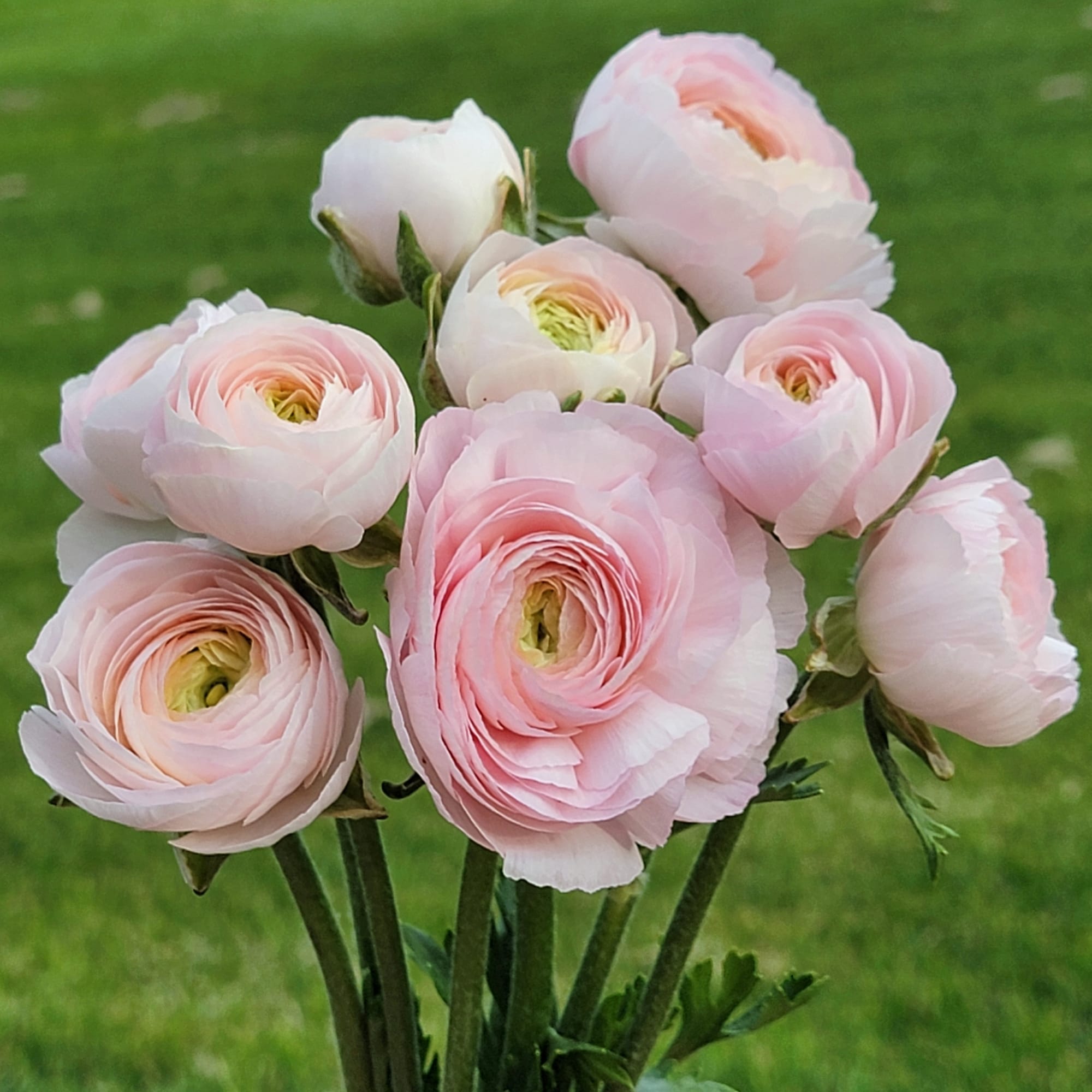Growing Ranunculus/Anemones

Growing ranunculus and/or anemones can be tricky, but it is well worth the effort! Before we get to how to grow them, let's talk about the corm sizes.
Corm sizes range from 2-3 to 7+ and all of them should grow. However, I would only recommend size 3-4 and larger. The "size small" corms that I sell are size 3-4, and the Clone Eglantine ranunculus that are pictured here were grown from that size and bloomed beautifully as you can see (this year I'm offering the medium 4/5 corm size for this variety)! The advantage of growing larger corms is that you get more blooms per corm (particularly with ranunculus), but both will produce nice flowers, and I have not personally noticed a difference in bloom size between small and large corms, though this could be the case in some instances. Corm size doesn't matter quite as much for anemones, but size 4-5 is usually considered an excellent size for anemone corms, as it is a good balance between blooming quickly, producing a good number of blooms, and having a long blooming period.
Ranunculus and anemone corms sprout best if they are soaked before planting. I recommend soaking ranunculus corms for around three hours (no more than four) and anemone corms for 8 hours (12 hours for the largest size anemone corms). Both should receive oxygen as they soak. This is best accomplished by putting the bucket in which soaking the corms under dripping water so that the water dripping into the bucket introduces oxygen. If you can't do that, adding a small amount of hydrogen peroxide to the water can also help, since it breaks down water and oxygen when mixed with water. Even if I use the water dripping method (which I usually do), I often turn the dripping off for the last half hour and add a bit of peroxide to the water, because the peroxide also helps sanitize the corms.
After the corms are soaked, they should be put in a tray of slightly moistened potting soil to presprout (some people skip the presprouting, but it usually results in a much higher sprouting rate). I use Pro Mix potting soil, and it works really well. When I say slightly moistened, it needs to be thoroughly and evenly moistened, just not wet. You should not be able to squeeze water out of it, but it should definitely feel damp. Once I get the "soil" to the right consistency, I put about a 1-inch layer in a tray (keep it loose, not packed). Then lay the corms on the soil. They can be put very close together, but I prefer not to let them touch. Then put about an inch of the soil on top once the corms are all in place. Make sure the corms are completely covered. They don't need to be kept in a dark place in spite of what some have said, but they do need to be completely covered with soil. You want the soil to stay about the same amount of moisture, so do not pour water in to water them, but misting the surface of the soil can be helpful. You could also cover the tray to prevent evaporation, but if you do that you'll want to open it briefly once a day to let them get fresh air and reduce the chance of mold. They should be kept in a cool but not cold place until they sprout. I think the ideal temperature is 60 degrees. If you have the ability to initially put them in a 40-45° cooler (NOT freezer) for 3-5 days and then return them to the 60° temperatures, I have found that can improve the sprouting percentage even more. But that step isn't necessary if you don't have a cooler or large enough refrigerator to do that.
You should see growth in 10-14 days. Put them under lights once it seems that the majority of them have sprouted (or you could plant them out if your outdoor temperatures are right for them). Even at that stage they still like the 60° temperature if possible, but they can handle anything from 40° to 70° without too much stress (make sure the temperatures in your grow room or greenhouse don't elevate to above 70°). If you're putting them under lights, they do well for 2-3 weeks, and then it is best to plant them out if possible. Protect them from anything below 35° when you first plant them out, and use shade cloth for the first few days if you haven't hardened them off before planting out. Once they are fully hardened off and their roots are established (probably after three weeks or so of being in the ground) they can handle down to 28° without protection. They should be planted in well draining soil and kept moist but not wet. The corms will rot (even after they're sprouted) if they sit for too long in wet soil.
Ranunculus are fairly easy to grow after they are sprouted and established in their final growing beds, so don't let all the instructions above turn you off from growing them! Please let me know if you have questions or if your growing experience contradicts anything I have stated above or if I've missed anything that should be mentioned in the instructions. Happy growing!


